CHEVROLET EQUINOX 2007 1.G Repair Manual
Manufacturer: CHEVROLET, Model Year: 2007, Model line: EQUINOX, Model: CHEVROLET EQUINOX 2007 1.GPages: 492, PDF Size: 2.62 MB
Page 61 of 492
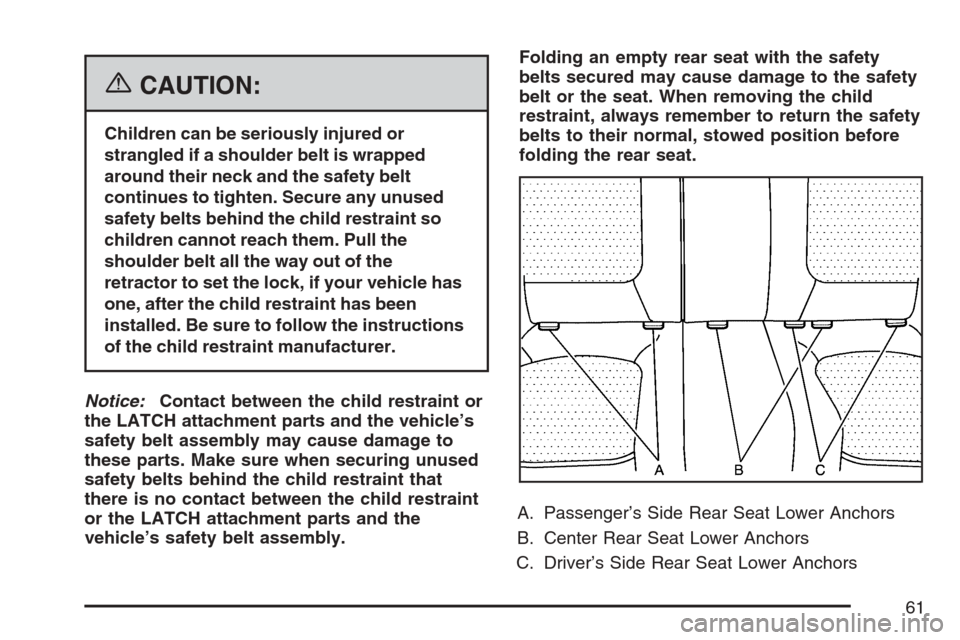
{CAUTION:
Children can be seriously injured or
strangled if a shoulder belt is wrapped
around their neck and the safety belt
continues to tighten. Secure any unused
safety belts behind the child restraint so
children cannot reach them. Pull the
shoulder belt all the way out of the
retractor to set the lock, if your vehicle has
one, after the child restraint has been
installed. Be sure to follow the instructions
of the child restraint manufacturer.
Notice:Contact between the child restraint or
the LATCH attachment parts and the vehicle’s
safety belt assembly may cause damage to
these parts. Make sure when securing unused
safety belts behind the child restraint that
there is no contact between the child restraint
or the LATCH attachment parts and the
vehicle’s safety belt assembly.Folding an empty rear seat with the safety
belts secured may cause damage to the safety
belt or the seat. When removing the child
restraint, always remember to return the safety
belts to their normal, stowed position before
folding the rear seat.
A. Passenger’s Side Rear Seat Lower Anchors
B. Center Rear Seat Lower Anchors
C. Driver’s Side Rear Seat Lower Anchors
61
Page 62 of 492

Make sure to attach the child restraint at the
proper anchor location.
This system is designed to make installation of
child restraints easier. When using lower anchors,
do not use the vehicle’s safety belts. Instead
use the vehicle’s anchors and child restraint
attachments to secure the restraints. Some
restraints also use another vehicle anchor to
secure a top tether.
1. Attach and tighten the lower attachments to
the lower anchors. If the child restraint does
not have lower attachments or the desired
seating position does not have lower anchors,
secure the child restraint with the top tether
and the safety belts. Refer to your child
restraint manufacturer instructions and the
instructions in this manual.
1.1. Find the lower anchors for the desired
seating position.
1.2. Put the child restraint on the seat.
1.3. Attach and tighten the lower
attachments on the child restraint to the
lower anchors.2. If the child restraint manufacturer recommends
that the top tether be attached, attach and
tighten the top tether to the top tether anchor,
if equipped. Refer to the child restraint
instructions and the following steps:
2.1. Find the top tether anchor.
2.2. You may need to adjust the rear
compartment storage panel/cover in
the rear cargo area to access the
anchors. SeeRear Compartment
Storage Panel/Cover on page 140.
2.3. Route, attach and tighten the top tether
according to your child restraint
instructions and the following
instructions:
If the position you are
using does not have a
head restraint and
you are using a single
tether, route the
tether over the
seatback.
62
Page 63 of 492
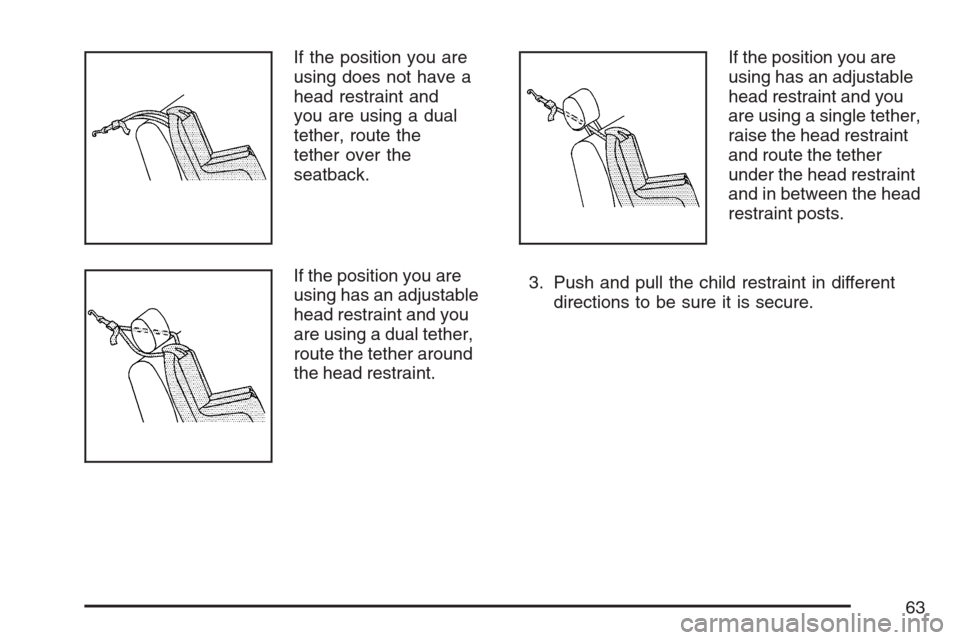
If the position you are
using does not have a
head restraint and
you are using a dual
tether, route the
tether over the
seatback.
If the position you are
using has an adjustable
head restraint and you
are using a dual tether,
route the tether around
the head restraint.If the position you are
using has an adjustable
head restraint and you
are using a single tether,
raise the head restraint
and route the tether
under the head restraint
and in between the head
restraint posts.
3. Push and pull the child restraint in different
directions to be sure it is secure.
63
Page 64 of 492
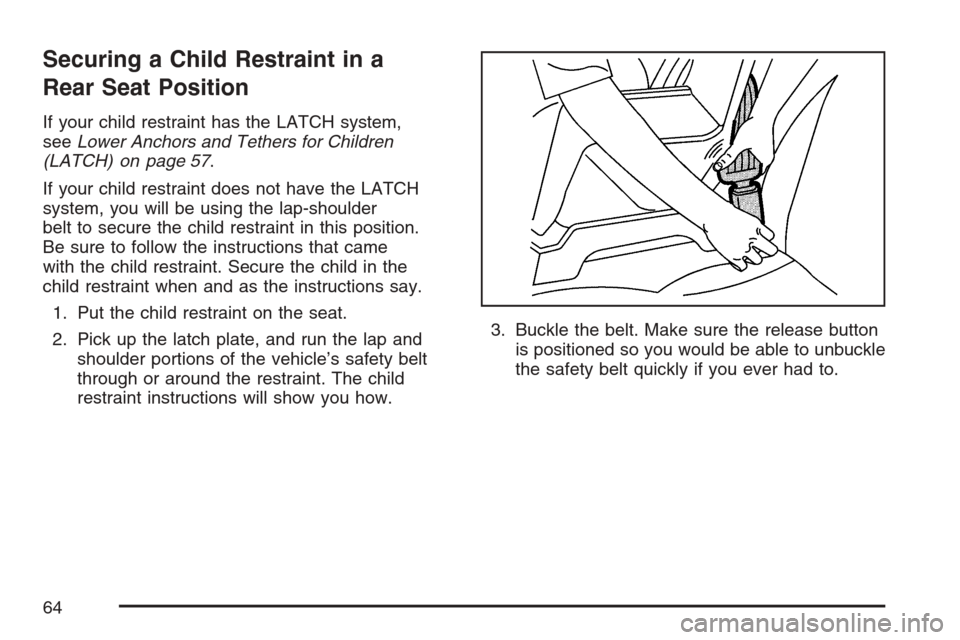
Securing a Child Restraint in a
Rear Seat Position
If your child restraint has the LATCH system,
seeLower Anchors and Tethers for Children
(LATCH) on page 57.
If your child restraint does not have the LATCH
system, you will be using the lap-shoulder
belt to secure the child restraint in this position.
Be sure to follow the instructions that came
with the child restraint. Secure the child in the
child restraint when and as the instructions say.
1. Put the child restraint on the seat.
2. Pick up the latch plate, and run the lap and
shoulder portions of the vehicle’s safety belt
through or around the restraint. The child
restraint instructions will show you how.3. Buckle the belt. Make sure the release button
is positioned so you would be able to unbuckle
the safety belt quickly if you ever had to.
64
Page 65 of 492
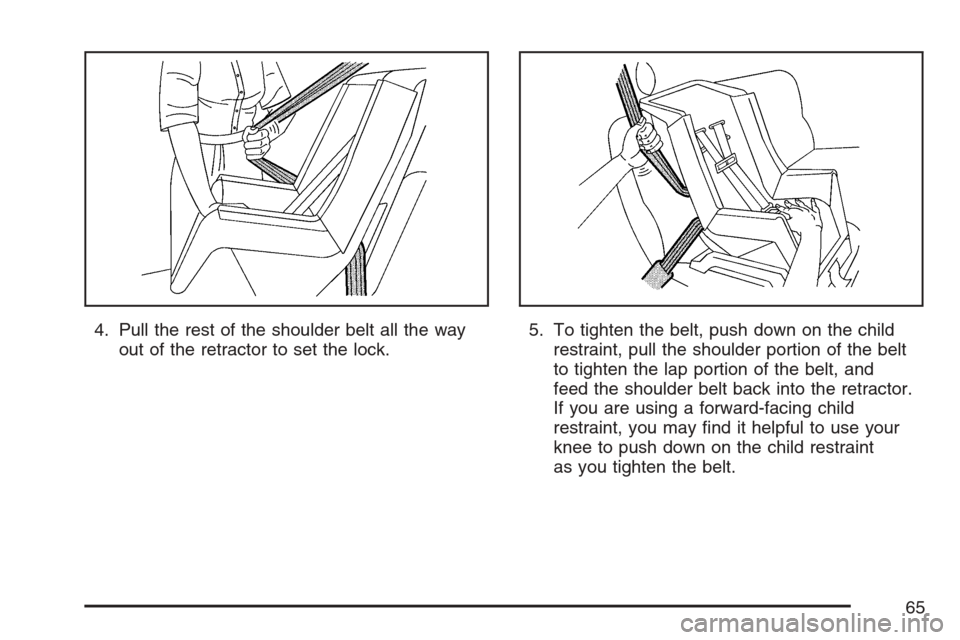
4. Pull the rest of the shoulder belt all the way
out of the retractor to set the lock.5. To tighten the belt, push down on the child
restraint, pull the shoulder portion of the belt
to tighten the lap portion of the belt, and
feed the shoulder belt back into the retractor.
If you are using a forward-facing child
restraint, you may �nd it helpful to use your
knee to push down on the child restraint
as you tighten the belt.
65
Page 66 of 492
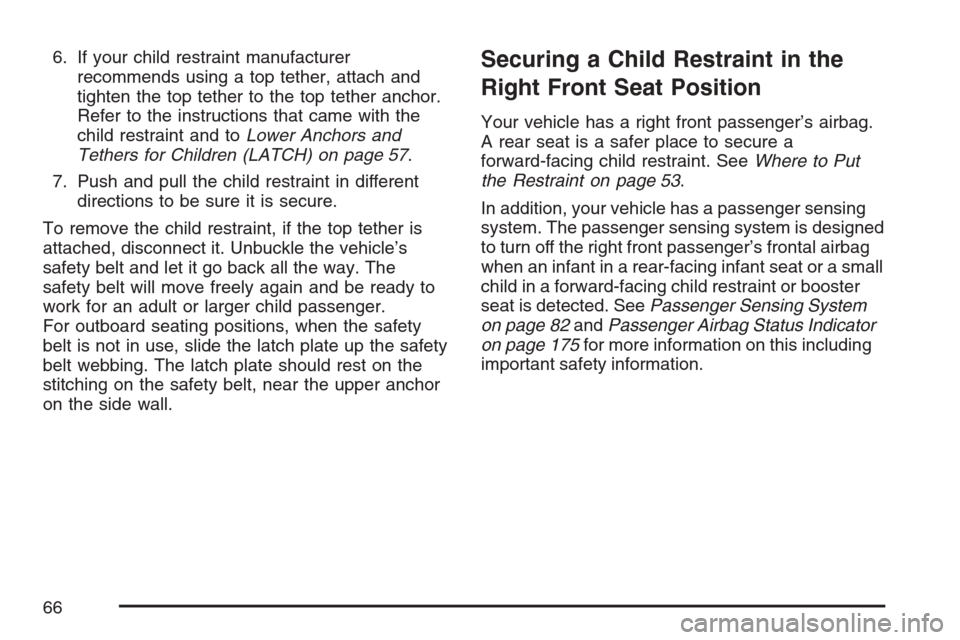
6. If your child restraint manufacturer
recommends using a top tether, attach and
tighten the top tether to the top tether anchor.
Refer to the instructions that came with the
child restraint and toLower Anchors and
Tethers for Children (LATCH) on page 57.
7. Push and pull the child restraint in different
directions to be sure it is secure.
To remove the child restraint, if the top tether is
attached, disconnect it. Unbuckle the vehicle’s
safety belt and let it go back all the way. The
safety belt will move freely again and be ready to
work for an adult or larger child passenger.
For outboard seating positions, when the safety
belt is not in use, slide the latch plate up the safety
belt webbing. The latch plate should rest on the
stitching on the safety belt, near the upper anchor
on the side wall.Securing a Child Restraint in the
Right Front Seat Position
Your vehicle has a right front passenger’s airbag.
A rear seat is a safer place to secure a
forward-facing child restraint. SeeWhere to Put
the Restraint on page 53.
In addition, your vehicle has a passenger sensing
system. The passenger sensing system is designed
to turn off the right front passenger’s frontal airbag
when an infant in a rear-facing infant seat or a small
child in a forward-facing child restraint or booster
seat is detected. SeePassenger Sensing System
on page 82andPassenger Airbag Status Indicator
on page 175for more information on this including
important safety information.
66
Page 67 of 492
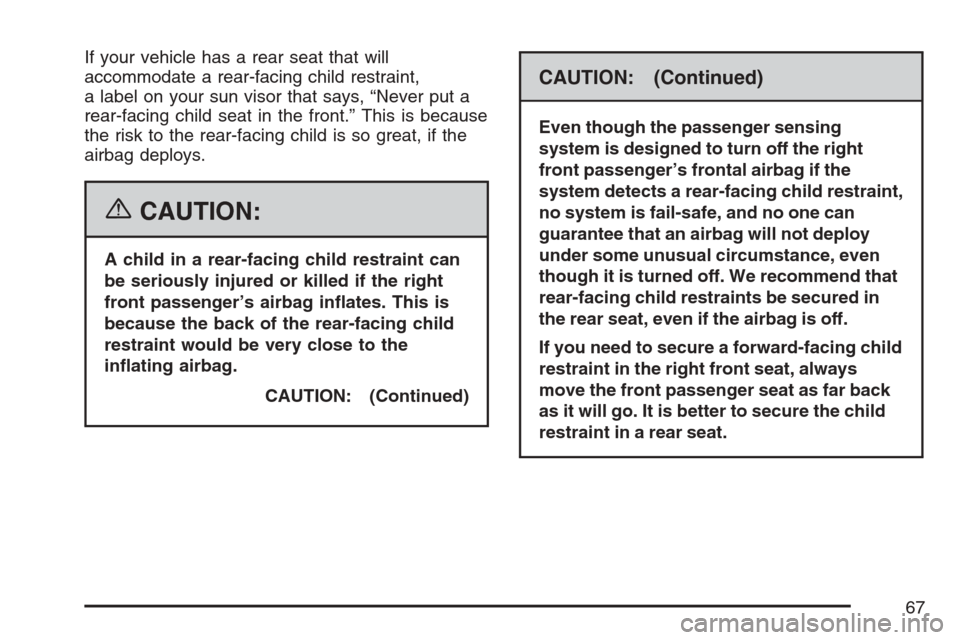
If your vehicle has a rear seat that will
accommodate a rear-facing child restraint,
a label on your sun visor that says, “Never put a
rear-facing child seat in the front.” This is because
the risk to the rear-facing child is so great, if the
airbag deploys.
{CAUTION:
A child in a rear-facing child restraint can
be seriously injured or killed if the right
front passenger’s airbag in�ates. This is
because the back of the rear-facing child
restraint would be very close to the
in�ating airbag.
CAUTION: (Continued)
CAUTION: (Continued)
Even though the passenger sensing
system is designed to turn off the right
front passenger’s frontal airbag if the
system detects a rear-facing child restraint,
no system is fail-safe, and no one can
guarantee that an airbag will not deploy
under some unusual circumstance, even
though it is turned off. We recommend that
rear-facing child restraints be secured in
the rear seat, even if the airbag is off.
If you need to secure a forward-facing child
restraint in the right front seat, always
move the front passenger seat as far back
as it will go. It is better to secure the child
restraint in a rear seat.
67
Page 68 of 492
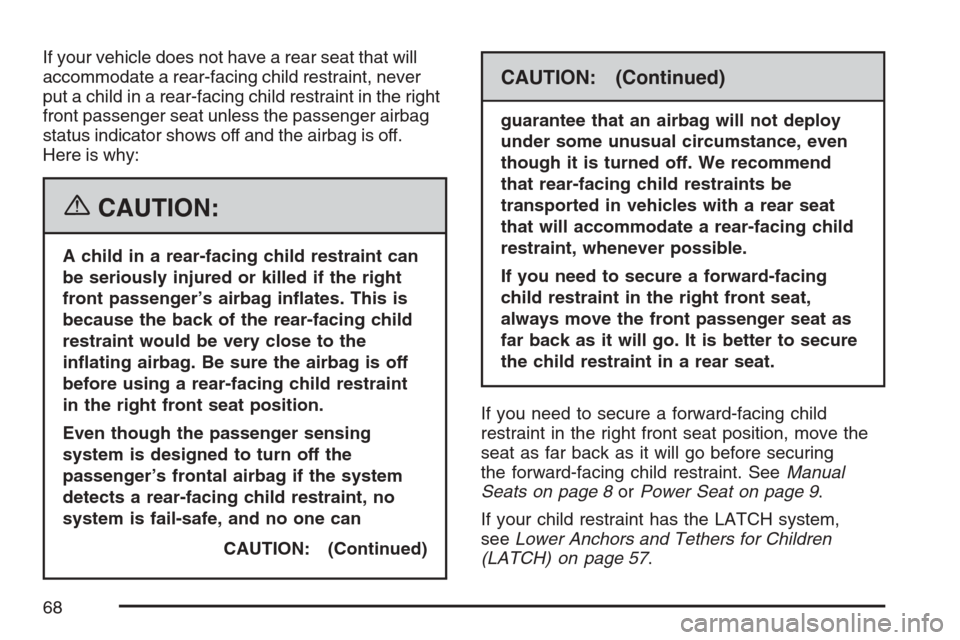
If your vehicle does not have a rear seat that will
accommodate a rear-facing child restraint, never
put a child in a rear-facing child restraint in the right
front passenger seat unless the passenger airbag
status indicator shows off and the airbag is off.
Here is why:
{CAUTION:
A child in a rear-facing child restraint can
be seriously injured or killed if the right
front passenger’s airbag in�ates. This is
because the back of the rear-facing child
restraint would be very close to the
in�ating airbag. Be sure the airbag is off
before using a rear-facing child restraint
in the right front seat position.
Even though the passenger sensing
system is designed to turn off the
passenger’s frontal airbag if the system
detects a rear-facing child restraint, no
system is fail-safe, and no one can
CAUTION: (Continued)
CAUTION: (Continued)
guarantee that an airbag will not deploy
under some unusual circumstance, even
though it is turned off. We recommend
that rear-facing child restraints be
transported in vehicles with a rear seat
that will accommodate a rear-facing child
restraint, whenever possible.
If you need to secure a forward-facing
child restraint in the right front seat,
always move the front passenger seat as
far back as it will go. It is better to secure
the child restraint in a rear seat.
If you need to secure a forward-facing child
restraint in the right front seat position, move the
seat as far back as it will go before securing
the forward-facing child restraint. SeeManual
Seats on page 8orPower Seat on page 9.
If your child restraint has the LATCH system,
seeLower Anchors and Tethers for Children
(LATCH) on page 57.
68
Page 69 of 492
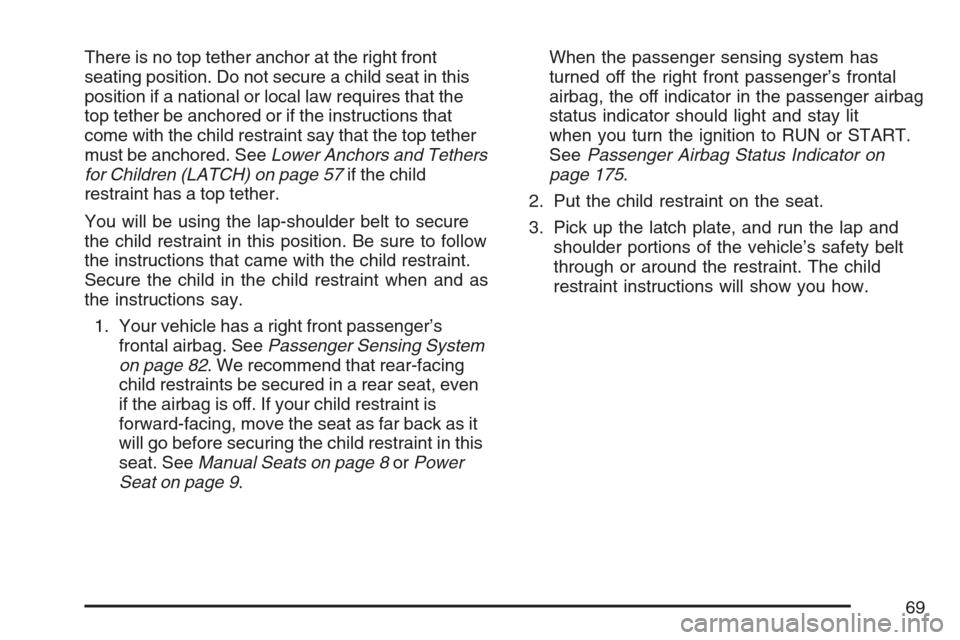
There is no top tether anchor at the right front
seating position. Do not secure a child seat in this
position if a national or local law requires that the
top tether be anchored or if the instructions that
come with the child restraint say that the top tether
must be anchored. SeeLower Anchors and Tethers
for Children (LATCH) on page 57if the child
restraint has a top tether.
You will be using the lap-shoulder belt to secure
the child restraint in this position. Be sure to follow
the instructions that came with the child restraint.
Secure the child in the child restraint when and as
the instructions say.
1. Your vehicle has a right front passenger’s
frontal airbag. SeePassenger Sensing System
on page 82. We recommend that rear-facing
child restraints be secured in a rear seat, even
if the airbag is off. If your child restraint is
forward-facing, move the seat as far back as it
will go before securing the child restraint in this
seat. SeeManual Seats on page 8orPower
Seat on page 9.When the passenger sensing system has
turned off the right front passenger’s frontal
airbag, the off indicator in the passenger airbag
status indicator should light and stay lit
when you turn the ignition to RUN or START.
SeePassenger Airbag Status Indicator on
page 175.
2. Put the child restraint on the seat.
3. Pick up the latch plate, and run the lap and
shoulder portions of the vehicle’s safety belt
through or around the restraint. The child
restraint instructions will show you how.
69
Page 70 of 492
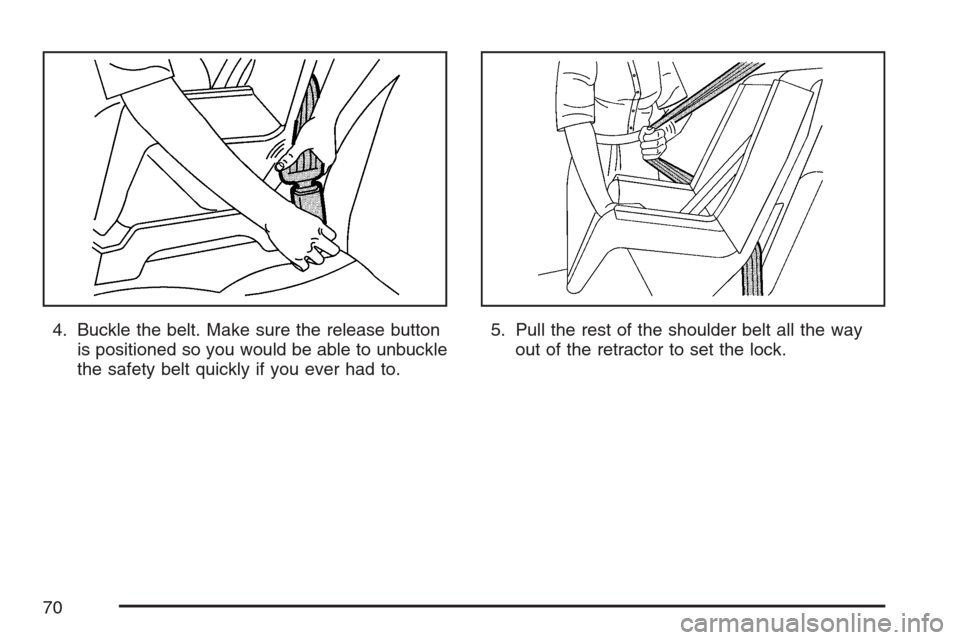
4. Buckle the belt. Make sure the release button
is positioned so you would be able to unbuckle
the safety belt quickly if you ever had to.5. Pull the rest of the shoulder belt all the way
out of the retractor to set the lock.
70